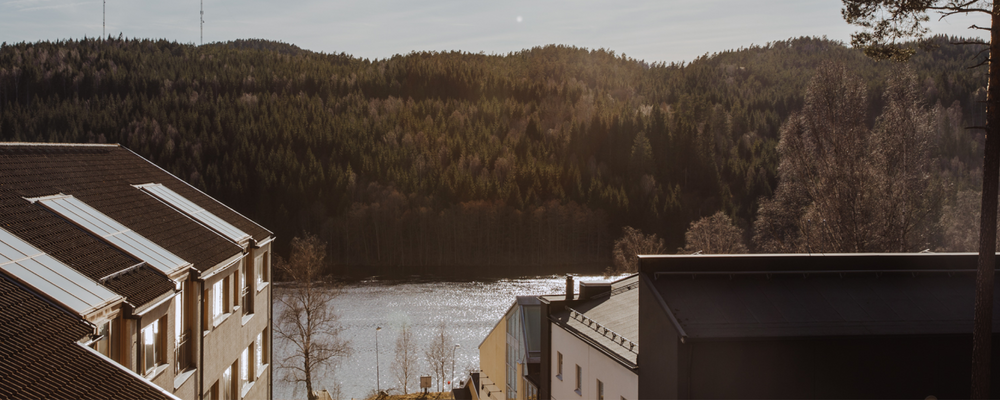
Campus Steneby – Where People, Ideas and Materials Meet
Campus Steneby is a unique environment for education and research in craft and design at Gothenburg University. Nestled among the lakes and forests of Dalsland midway between Gothenburg and Oslo—we are an international community of makers, artists and designers who are attracted by our philosophy of education that involves total immersion in the workshop experience.
In our educations, we seek to develop knowledge of heritage and traditions as a basis for pushing the boundaries of material-based craft and design. With a strong focus on artistic exploration and design methods, we provide students with the tools to enable the application of their skills to new contexts in a rapidly changing world.
Our world-class facilities, including the largest academic metal workshop in the EU and the ongoing establishment of a testbed for the furniture industry, make us a clear choice for those seeking the possibility to develop their skills and knowledge in the tranquility of natural surroundings. All of our degrees are offered in English, making Campus Steneby a diverse environment for cultural exchange, with an alumni network spread across the world.
We offer BFA degrees in Metal Art, Wood Oriented Furniture Design and Crafting Futures, where we focus on the development of technical skills, material knowledge, project planning, as well as history and theory. Our MFA in Applied Art and Design a two-year programme that invites practitioners to develop their own approach to practice in one of our material disciplines.
We also offer independent courses for those who would like to try out life at Campus Steneby for a shorter period of time. Our partners Stenebyskolan, with whom we share a range of facilities, offer preparatory and vocational education in art, craft and design as well as a range of summer courses.
Our Heritage
Craft education at Steneby is rooted in the Swedish handicrafts revival of early twentieth century when a return to traditional knowledge and techniques in craft education were promoted by Carl Malmsten at Nääs – an internationally renowned centre for the development of Swedish slojd approach in teacher education.
Erland Borglund, who attended Nääs in the 1920s, soon began to collaborate with Malmsten and developed courses in woodwork for teenage boys in Dals Långed. Steneby Hemslöjdsföreningen was established in 1929 and became an important focal point for the preservation of local craft knowledge, particularly straw craft which had been an important cottage industry in Dalsland since the years of famine and mass emigration in the 1860s. Craft training was seen as an important antidote to the social problems associated with the great depression of the 1930s. Soon, handicrafts from Dals Långed were being exhibited at international exhibitions in Stockholm and London.
A school was established in 1934 with Borglund as rector, with the first modern building of the campus, a functionalist-style student dormitories and a cafeteria – opening in 1938. By the advent of the Second World War, the school offered courses in weaving, straw craft, carpentry, wood carving, turning, painting, bookbinding, ironwork, ceramics, tailoring, house construction and interior design.
After the second world war, the school became integrated into the Swedish state system of education and new buildings were added throughout the 1960s. In 1991, Stenebyskolan started operating as a foundation and has developed a focus on preparatory art and vocational education.
spin-off effects I Dals långed
Since the early 2000s, Dals Långed has offered university-level education in the fields of metal art, furniture design and textiles – with degrees certified by the University of Gothenburg. This has brought investment to the school, including the construction of our state-of-the art forge and digital technologies in the wood workshops and the expansion of textile facilities. Over the years, the school has become gradually more integrated with the Artistic Faculty and closely collaborates in sharing knowledge and educational opportunities.
Following a trend towards socio-economic decline in Dalsland during the late twentieth century, the cultural center Not Quite, and the recently established studio and co-working space Studio Växt are show that our university educations have spin-off effects that benefit the local society and economy. In the twenty-first century we have renewed our commitment to Borglund’s mission of pursuing crafts and design as a socially important activities that can benefit our surroundings, both locally and internationally.
Campus Life
The Steneby environment includes a library, exhibition hall, cafeteria, and an active student union who organize a range of activities in the evenings and at weekends. Around 70 students attend programmes at the University of Gothenburg – Campus Steneby, while around 120 students are enrolled at Stenebyskolan. Staff and students frequently come together to attend talks by guest teachers and artists from around the world.
In the village, it is possible to take a sauna by the lake, hire kayaks, produce ceramics at the ceramics kiosk, take a yoga class, play boule or hire a bike and explore the surrounding area. In the village you will find a supermarket and two pizzerias, while in the near vicinity you will find the cultural centre Not Quite, Dalslands Konstmuseum and much more.



Research and Innovation at Campus Steneby
In 2022, Campus Steneby was announced as the site of investment for the establishment of a new centre for research and innovation related to the furniture and interiors industries in Sweden. This is a collaboration between the University of Gothenburg and our partners at Mötesplats Steneby, Region Västra Götaland, and the European Regional Development fund.
Many of our teachers are also active researchers, more information on research interests can be found on their staff profile pages.










